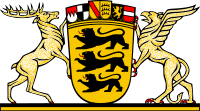Wikipedia:WikiProject Germany/Portal:Baden-Württemberg
Introduction

Baden-Württemberg (/ˌbɑːdən ˈvɜːrtəmbɜːrɡ/ BAH-dən VURT-əm-burg, German: [ˌbaːdn̩ ˈvʏʁtəmbɛʁk] ), commonly shortened to BW or BaWü, is a German state (Land) in Southwest Germany, east of the Rhine, which forms the southern part of Germany's western border with France. With more than 11.07 million inhabitants across a total area of nearly 35,752 km2 (13,804 sq mi), it is the third-largest German state by both area (behind Bavaria and Lower Saxony) and population (behind North Rhine-Westphalia and Bavaria). As a federated state, Baden-Württemberg is a partly-sovereign parliamentary republic. The largest city in Baden-Württemberg is the state capital of Stuttgart, followed by Mannheim and Karlsruhe. Other major cities are Freiburg im Breisgau, Heidelberg, Heilbronn, Pforzheim, Reutlingen, Tübingen, and Ulm.
What is now Baden-Württemberg was formerly the historical territories of Baden, Prussian Hohenzollern, and Württemberg. Baden-Württemberg became a state of West Germany in April 1952 through the merger of South Baden, Württemberg-Baden, and Württemberg-Hohenzollern. These three states had been artificially created by the Allies after World War II out of the existing traditional states by their separation over different occupation zones.
Baden-Württemberg is especially known for its strong economy with various industries like car manufacturing, electrical engineering, mechanical engineering, the service sector, and more. It has the third-highest gross regional product (GRP) in Germany. Part of the Four Motors for Europe and located in the Blue Banana, some of the largest German companies are headquartered in Baden-Württemberg, including Mercedes-Benz Group, Schwarz Group, Porsche, Bosch and SAP.
The sobriquet Ländle, a diminutive of the word Land in the local Swabian, Alemannic and Franconian dialects, is sometimes used as a synonym for Baden-Württemberg. (Full article...)
Selected article

The coat of arms of Baden-Württemberg was determined after the merging of the former German states Baden, Württemberg-Baden and Württemberg-Hohenzollern, that were divided due to different occupying forces after World War II, in 1952. The creation of the state was not without controversies and thus only the state colours black and gold were determined in 1952, but not yet the arms. The latter were only regulated in the Gesetz über das Wappen des Landes Baden-Württemberg (Law on the Coat of Arms of Baden-Württemberg) of 3 May 1954. Its use is moreover regulated by an order dated 2 August 1954. It was designed by Fritz Reinhardt.
The shield shows three black lions with red tongues on a golden background. The arms refer to the coat of arms of the Duke of Swabia whose House of Hohenstaufen had used these arms. The name of Suabia had long been discussed for use with the newly created state but it failed to be adopted due to resistance from parts of Baden.
Selected biography

Hans Bayer, known by the pseudonym Thaddäus Troll, (18 March 1914 – 5 July 1980) was a German journalist and writer and one of the most prominent modern poets in the Swabian German dialect. In his later years he was also an active campaigner for libraries and for support, pension rights and fair publishing contracts for writers. He was born in Bad-Cannstatt, a suburb of Stuttgart and committed suicide there at the age of 66. The literary award, Thaddäus-Troll-Preis, is named in his honour. His family had a soap-making business in the town. After he finished his secondary education at the Johannes-Kepler-Gymnasium, he worked briefly as a volunteer at a newspaper in Cannstatt. He then studied German, art history, comparative literature, theater, and journalism at the universities of Tübingen, Munich, Halle, and Leipzig, receiving his doctorate in 1938 from Leipzig University.
State facts
- Nickname: Ländle
- Capital: Stuttgart
- Minister-president: Winfried Kretschmann
- Governing parties: Greens / CDU
- Total area: 35,751 km2 (13,804 sq mi)
- Population: 10,879,618 (2015)
- Founded: April 25, 1952
- Website: www.baden-wuerttemberg.de
Selected image

Fortress ruins of the Hohentwiel, taken from an airplane
Did you know?

- ...that Rottweil is the oldest town in Baden-Württemberg? Its appearance has changed very little since the 16th century. The old town is famous for its medieval center and for its traditional carnival.
- ...that Fernsehturm Stuttgart was the first telecommunications tower in the world constructed from reinforced concrete? It is the prototype for many such towers worldwide.
Subcategories
Selected panorama
 |
The New Palace (German: Neues Schloss) is an 18th century Baroque palace and is one of the last large city palaces built in Southern Germany. The palace is located in the center of Stuttgart on the Schlossplatz in front of the Jubiläumssäule column and Königsbau. Public tours of the building are only permitted by special arrangement, as the building contains some government offices.
Topics
Related portals
Associated Wikimedia
The following Wikimedia Foundation sister projects provide more on this subject:
-
Commons
Free media repository -
Wikibooks
Free textbooks and manuals -
Wikidata
Free knowledge base -
Wikinews
Free-content news -
Wikiquote
Collection of quotations -
Wikisource
Free-content library -
Wikiversity
Free learning tools -
Wikivoyage
Free travel guide -
Wiktionary
Dictionary and thesaurus















